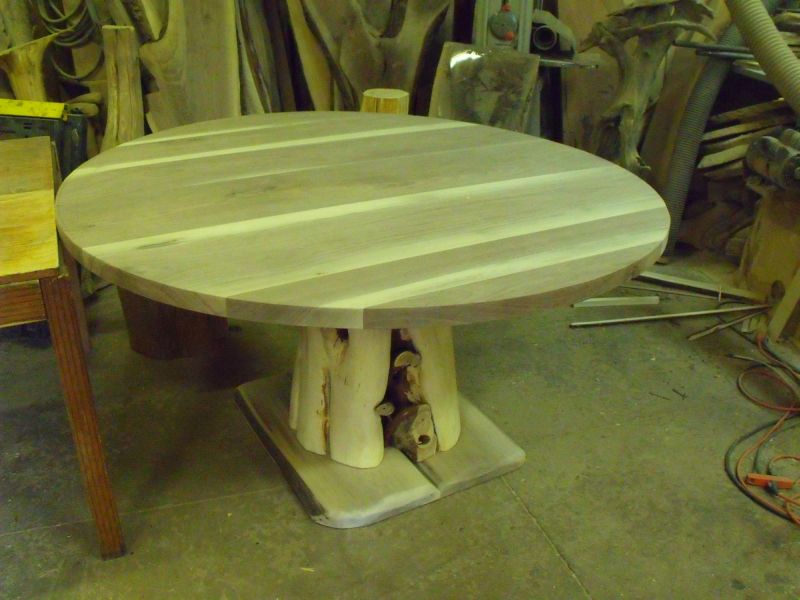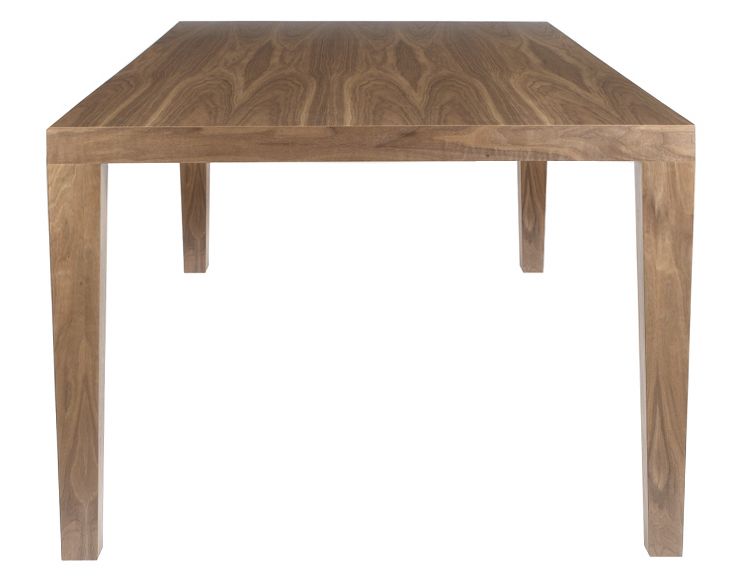End Joint Splitting in Table Glue-Ups
Here's a long troubleshooting discussion about splits that form at the end joints between boards in a round table top. August 29, 2014
Question (WOODWEB Member) :
Iím a rustic furniture maker and Iím having a problem with glue joints. On occasion when I glue up 2" thick walnut I have the very end of the joint open or expand. What would cause this? I use either a straight line rip saw, or my joiner and make sure I get a tight joint and plenty of glue (Titebond II) with bar clamps. The joint will look fine through the whole sanding and finishing process and then it opens, sometimes a day later and sometimes weeks later.

Click here for higher quality, full size image
Forum Responses
(Furniture Making Forum)
From Contributor J:
My first thought is, how dry is your wood? Is it aged and/or dry enough? It sounds like the wood is not stable. Also, does this only happen where you have sapwood glued to heartwood like the picture shows?
From the original questioner:
Even when I glue heart to heart, the wood is all kiln dried down to 8% but I really think the kiln operator dries walnut too quick.
From contributor G:
As you go around the radius, progressively more end grain is exposed and then progressively less. Please try to picture this. A square tabletop does not pose this situation at any pont in the end grain orientation.
From Contributor J:
I think the answer is to age your wood longer before using it. I know that's not
always possible.
From the original questioner:
The material Iím using has been in the shop for year or two. It was kiln dried to 8% back then and it is also happening in my square joint tables.
From contributor B:
Does this only happen with walnut and only at 2" thick? What about cherry, or maple? If it is only walnut I would switch suppliers and see what happens.
From Contributor H:
How are you finishing the tops and what is the relative humidity in the location they are being stored? It sounds a lot like the wood is drying out at the butt ends through the end grain much the way you get checking at board ends during drying. I'd look at what you are doing to seal the ends of the boards during finishing. Also, are you doing fine sanding of the butt ends?
From contributor J:
Contributor H is right to ask about the storage conditions. The wood may have been dried to 8%, but what is its moisture content after storage? If you are storing it in an unheated space, bringing it into a heated shop will cause it to lose moisture mostly through the exposed end grain. Results; split ends. This problem is almost surely being caused by moisture loss after glue-up, so you need to control the moisture content better. If the material is stored in the same area it's glued up, perhaps there are wide swings in relative humidity that you can address through heating/ air conditioning/humidification. Do you have a hygrometer in the shop to monitor humidity?
From the original questioner:
I heat my shop with a gas blue flame wall mount heater and I keep it at 65. The wood has been aged for long periods. We do fine-sand the ends and tops to 220 grit, and no I do not have the problem with cherry or maple. I do work with more walnut than anything else. I will need to get a humidity meter for the shop and see where that is at.
From contributor D:
To the original questioner: I know you said you use a straight line rip saw or a jointer to edge your boards before glue up. Do you make the glue-ups longer with the grain by much before cutting to final size or are you fairly close at glue up? Possibly you are getting a funky snipe or such on the end of each or some boards especially on the jointer. If so, try using longer stock and see if that eliminates the problem. Your wood sounds stable and if other wood stored the same is not problematic I would guess your seam edges are the culprit.
From the original questioner:
I always try to make them 1" or to longer and then trim to length. Yes now and then I get the snipe at the ends but I see that in the glue-up and allow for trimming.
From contributor D:
I have had it as well. My theory on this is the snipe goes more than you think and even though subtle it is magnified by two times. I use Titebond and I think what happens is the moisture or water in the Titebond may cause some swelling to the edges but when completely dry may shrink even more than before. Just a hunch - make your boards longer and I believe the problem will go away.
From Contributor H:
When I make items like this I go overlong by 4" to 6", not 1" or so. I want plenty of material to cut away at the ends. The end snipe is certainly also a possibility along with moisture from the glue, especially if you are applying it heavy. We see the effects of the moisture in Titebond glues on a regular basis and have learned to accommodate that in our plans.
From contributor J:
It sounds like your storage is not the problem. I don't know why walnut would be more troublesome than cherry or maple. I would expect more failures with maple, as walnut is far more stable. It could be a problem with a specific batch of wood, maybe a kilning defect. It could be a machining problem, in which case correct it or cut longer to avoid it. It also could be glue related swelling/shrinking, in which case maybe another lower water content adhesive like UF or epoxy would be better. Maybe sealing the ends prior to glue-up and sealing right after sanding would help.
From Contributor H:
We do a lot of thin strip lamination work. With eight or fewer strips the strength of the wood makes for spring back which needs to be planned into the form radius. With 12 or more strips though we see what you might consider unexpected results. While with this many strips there are enough glue layers to counter act spring back we actually end up with spring IN. The moulding blank ends up a tighter radius the form. I may be wrong in this but my interpretation is that the moisture of the glue has swollen the wood fibers and forced to swell much like applying moisture to one side of a board making it cup.
We plan our bending form radius depending upon what we want for final results with the number of strips involved. Another place I've seen the effects of glue moisture is in the use of biscuit wafers. If you use wafers on the edge of 3/4" material you can get a swollen bump the shape of the wafer in the surface of the glued up board. If you sand the surface flat before the swollen area has a chance to shrink back down you can end up with a wafer shaped depression in the surface several weeks down the road.
From contributor E:
When you rip your walnut, does it stay straight and flat, or curve after ripping a piece off a big board? If so, no amount of monkeying around with glues and whatnot will help, as you'd be using case hardened lumber. This is a kiln drying problem.
From Contributor M:
As a side note with regards to the heat, one thing to remember is that un-vented wall heaters (assuming thatís what you mean by a blue flame heater) dump massive amounts of moisture into the space being heated from the gas. While cheap, they are one of the worst forms of heat for a structure (home) that is sealed up pretty well. Being a GC doing a lot of remodeling in rural areas the damage to an entire home is a common thing to see. Drywall, trim and cabinetry just canít handle the wild swings of the moisture they rapidly dump into a space. Of course in a very large/loose shop this would be less of an issue but an issue none the less. If this is in fact the type heater you have when you get your hygrometer just for fun, set it in the area over the heater and kick the heater on. The meter will likely spike to 90 plus or better in short order. I have often found spongy, damp, soggy, drywall in the area directly above an un-vented stove. As others have said it seems like your issues may not be related to this but itís something to consider.
From contributor R:
I don't think I saw anyone mention a sprung joint before glue-up. This is a very slight gap between the boards, just in the middle. You get the wood tighter at the ends to allow for the shrinkage you are talking about.
From the original questioner:
Yes I do have a blue flame heater, but my shop is in a garage with plenty of air leaks and all. I will check this out more - my material is at least 20 feet on the other side of the shop.
From contributor N:
I agree with Contributor M. One hundred percent those vent free heaters cause nothing but moisture problems. I have seen the same things in houses. When you posted that you used a blue flame heater that was my first thought on why you might be having problems. I would never heat a shop with one of those they use interior air for combustion and leave behind lots of moisture.
From contributor S:
Make sure you are not squeezing too much of the glue out of the joints with excessive clamping pressure. I have done this before, and experienced the same thing. You have to be careful with bar/pipe clamps. It is easy to get carried away.

